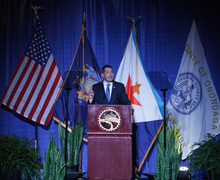‘Coming Back Together’ art honors Black, Latine alumni success
Ella Chan | Asst. Photo Editor
The works of Black and Latine Syracuse University alumni hang on the Community Folk Art Center's walls. The pieces aim to showcase diverse experiences through various art mediums, including photography, illustration and literature.
Get the latest Syracuse news delivered right to your inbox.
Subscribe to our newsletter here.
At the Community Folk Art Center, art by Syracuse University students and alumni depicts different Black and Latine experiences. This exhibition, “Community & Connection,” represents the homecoming and triumph that many Black and Latine alumni have felt since returning to SU, Hadassah Onimiya, CFAC administrative specialist, said.
“The opportunities are limitless in what you are able to accomplish if you really want to,” Onimiya said.
The exhibition honors the triennial Coming Back Together weekend at SU, celebrated this September. Due to such a positive response to the artwork, CFAC has extended the exhibition’s display through Nov. 30, Onimiya said. Featured is poetry from SU alumni Cedric T. Bolton, illustrations from London Ladd and photography from JoAnn Onofre and current SU graduate student Chelsea Reeves.
The staff hopes the exhibition will remind students of the different ways they too can be successful in the arts. The featured artists made noise in the arts community through illustration work in publications like the New York Times and solo photography galleries.
“If you want to be an artist in any way shape or form, you definitely can be very successful in the future, because we have examples of past students who have been able to do so,” Onimiya said.
Ladd is an assistant teaching professor who graduated from SU with his bachelor’s and master’s in illustration. He uses acrylic paint on top of cut paper and tissue paper, applying it in ways that create different textures. Ladd enjoys working with tissue paper because of how unpredictable it can be, giving his pieces movement and imperfections.
Ladd selected pieces from his graduate studies and editorial illustrations he’s done for children’s books, such as “Black Gold” by Laura Obuobi. His work exhibits many familial parts of African American life, such as dancing and a mother braiding her child’s hair in the piece titled, “Every Saturday.”

Ella Chan | Asst. Photo Editor
Lydia’s Attic is run exclusively by volunteers who take shifts over the course of the weekend. Volunteers manage the shop, handle financial transactions and aid customers in their shopping experience.
Ladd grew up in the 1970s, struggling with his identity as a mixed man, since interracial relationships were disapproved of and uncommon. By expressing the beauty of Blackness, Ladd said these pieces helped him accept his own identity.
Through his work, Ladd tells a story, even if not related to the picture book it originates from. He hopes attendees take pride in their identity after seeing his work.
“You hope that there’s a connective tissue, pun intended, with the work and the viewer being brought in,” Ladd said.
Many SU students aren’t aware of the fact that CFAC is a part of the university, Onimiya said. So, Onimiya wants this exhibition to draw more students to witness work of the African diaspora and the experiences of these communities.
Current SU graduate student Chelsea Reeves bridges the gap between campus and CFAC with her photography, she said. She brought in people who had never been to CFAC and those who just wanted to support her.
“I have a lot of connections to not just my community, but other different communities on campus. Showcasing my work here brought a lot of different audiences to the art center,” Reeves said.
One of Reeves’ five photographs portrays the hair of a Black woman that resembles Medusa. Reeves submitted the pieces because they reflect the entirety of Black culture, not just any one aspect.
Reeves said that the exhibition provides Black and Latine artists with a platform to speak on personal experiences as they’ve moved through the world. It’s also a space where students and graduates can feature their work before they become more mainstream.
“When everybody came back together, it was from all different walks of life, everybody was on their own journey,” Reeves said. “Coming back and being able to see pieces they can resonate with and relate to in any way, shape or form, is a reflection of Coming Back Together.”
Published on November 11, 2024 at 10:22 pm






